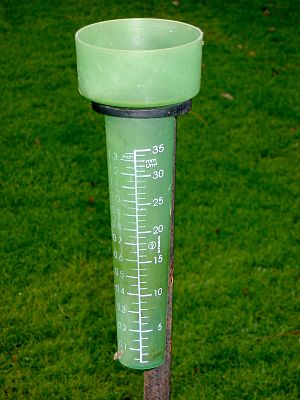Pluviometry facts for kids
Have you ever wondered how scientists know exactly how much rain falls during a storm? That's where pluviometry comes in! It's a special part of meteorology, which is the study of weather. Pluviometry focuses on measuring rainfall. The word "pluviometry" comes from two older words: pluvius, a Latin word meaning "rain," and metron, a Greek word meaning "measure." So, it literally means "rain measure." The main tool used to measure rain is called a rain gauge or a pluviometer.
Contents
What is Pluviometry?
Pluviometry is the science of measuring how much rain, snow, or hail falls from the sky. It helps us understand weather patterns and how much water is available in different places. This information is super important for many reasons, from farming to predicting floods.
Why Do We Measure Rain?
Measuring rainfall is more important than you might think! Here are some key reasons:
- Farming: Farmers need to know how much rain their crops are getting. Too little rain means drought, and too much can cause floods that damage plants.
- Water Supply: Cities and towns rely on rain to fill reservoirs and provide drinking water. Knowing rainfall amounts helps manage these water supplies.
- Flood Prediction: Meteorologists use rainfall data to predict when rivers might overflow. This gives people time to prepare for floods and stay safe.
- Climate Study: Over many years, rainfall data helps scientists understand how Earth's climate is changing.
- Construction: Engineers need to know typical rainfall levels when designing buildings, roads, and drainage systems to make sure they can handle the water.
How Do Rain Gauges Work?
A rain gauge is the main tool used in pluviometry. It's a simple device that collects and measures precipitation. Most rain gauges have a funnel that collects rain and directs it into a measuring tube or container. The amount of rain is then read from a scale, usually in millimeters or inches.
Different Kinds of Rain Gauges
There are several types of rain gauges, each with its own way of measuring:
- Standard Rain Gauge: This is the most common type. It's a simple cylinder with a funnel at the top. The rain collects in a smaller, inner tube that has a scale for accurate readings. Any overflow goes into a larger outer container.
- Tipping Bucket Rain Gauge: This is an automatic gauge. It has two small buckets that tip back and forth like a seesaw. When one bucket fills with a tiny amount of rain (like 0.2 mm or 0.01 inches), it tips, empties, and sends an electrical signal. The other bucket then moves into place to collect rain. A computer counts the tips to measure the total rainfall.
- Weighing Rain Gauge: This type collects rain in a bucket that sits on a weighing scale. As rain falls into the bucket, its weight increases. The scale records this weight change, which is then converted into a rainfall amount. This gauge can also measure snow and hail.
Where to Place a Rain Gauge
For accurate measurements, a rain gauge needs to be placed carefully. It should be in an open area, away from tall buildings, trees, or other obstacles that could block the rain or cause wind to affect the collection. It's usually placed about one meter (three feet) above the ground.
Measuring Rain: Units and History
Rainfall is typically measured in millimeters (mm) or inches (in). For example, if a rain gauge shows 10 mm of rain, it means that if the rain stayed where it fell without soaking into the ground or evaporating, it would form a layer 10 mm deep.
People have been trying to measure rain for a very long time. One of the earliest known rain gauges was developed in India around the 4th century BCE. Ancient Greece and China also had early methods for measuring rainfall to help with farming and water management. The first standardized rain gauge in Europe was invented in the 17th century.


